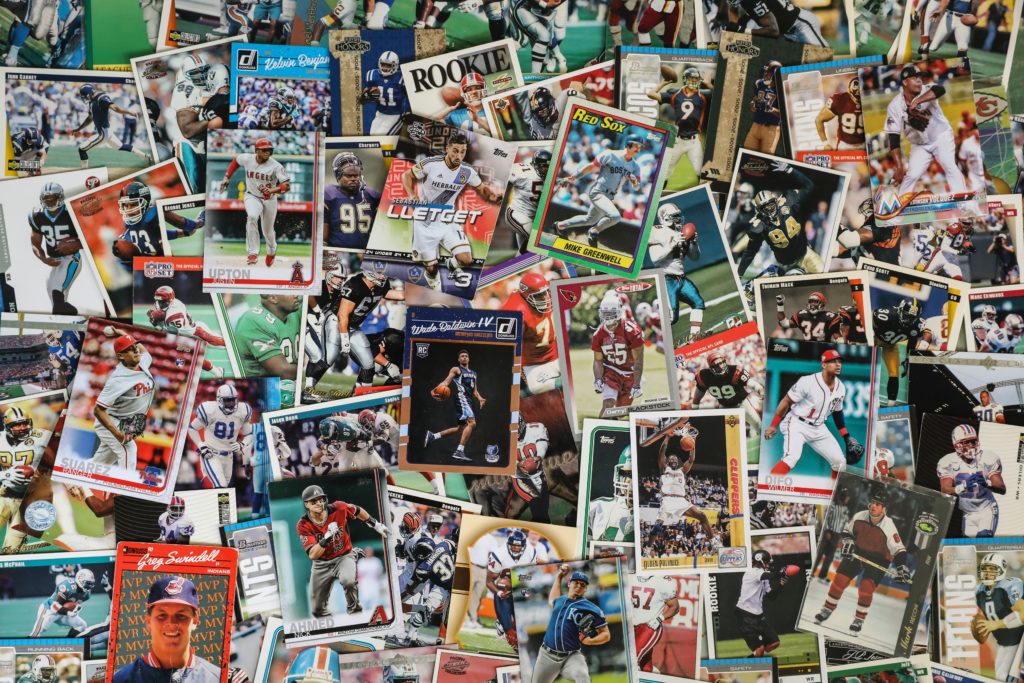
Getting Carded – Why Sports Cards Are Now Content
Getting Carded – Why Sports Cards Are Now Content https://csuiteold.c-suitenetwork.com/advisors/wp-content/uploads/sites/5/2021/11/mick-haupt-AJYmNfbcoRo-unsplash-1024x683.jpeg 1024 683 jeffreyhayzlett https://secure.gravatar.com/avatar/7d20a01ed9c1d91ad616e067720c7767?s=96&d=mm&r=g
The thrill of victory, the agony of defeat.
The old line from ABC’s Wide World of Sports perfectly sums up Americans’ obsession with sports. They are fanatics and will hang with their team from the best of times to the worst of times.
Professional sports fans can’t get enough of their favorite teams, or athletes, with licensed merchandise and other paraphernalia, which adds up to billions in sales.
One collectible that’s seemed to stand the test of time is sports cards. These are not the same cards that came with the chalky pink gum, or you used to stick in your bicycle spokes. Today’s sports cards are big business and even get traded on the blockchain. In fact, they are currently a $5.4 billion industry!
Sports cards became such a hot commodity during the peak of the pandemic that Target pulled new shipments off their shelves because people were fighting over boxes of new cards.
While cards are back on the shelf at Target, Jason Howarth, Vice President of Marketing for Panini America, says the thrill of the hunt and the uncertainty are big reasons customers are collecting.
“What happens when you’re opening up a product is that idea that you don’t know what’s inside the box. You open up that product and happen to hit that card. You know that you have a big one,” Jason said. “That’s the value that we bring to the collector and that when you collect our cards, you’re collecting them for enjoyment and entertainment. You may also be able to collect them for value and investment long term.”
Cards as Content
Panini has its roots in content, just not sports card content. The company began as a newspaper distributor in Italy back in the 1960s. In 1970, it started printing stickers for the World Cup, creating an international craze and the beginnings of a big business. Today, Panini prints sports cards and other licensed collectibles sold around the world.
While you may think of sports cards as a hobby, but Jason told me you should also see them as content.
“Every year, there’s a fresh group of players that come in,” Jason said. “You’re telling and building off of their stories. But, I think the thing that’s most powerful for us is that our product is the player. So, as the player performs on the field, we have an opportunity to tell that story with every player that kind of steps in and does something different and special.”
Panini America is doing more than telling stories by printing glossy cards. They have more than 2,000 athletes each year signing special edition cards. The company adds even more value by printing cards with pieces of the player’s jerseys, NASCAR racing items, and parts from arenas where big sports moments happen. Jason says these cards aren’t just notable for collectors and fans. The athletes get a kick out of them, too.
“It’s funny. It doesn’t matter how special that player is. Whether they’re a superstar or not. That first time you get a card in your hand, and it’s your card, it’s like a moment of validation,” Jason explains. “You grow up as a kid wanting to play pro sports. You want to hear your name called by your favorite team when you’re drafted. You want to hear your name called for the game-winning shot. The other side of that is seeing your first trading card. And every year that happens with every rookie class, and the designs now are so special that even those superstars, when they look at cards, they stop and take a look before they sign them, and they’re like ‘wow, this is incredible. Can I keep this?'”
Bye, Bye Bubble Gum. Hello Blockchain.
There have been many headlines about NFT’s (non-fungible tokens), digital collectibles that could be a picture, video highlights made in a limited run tracked by the blockchain. Sport NFTs are a current collectible craze, and Panini is on top of it. Jason says Panini started going digital in 2014 when it released an app for football and basketball cards. The company started digging into binging its product to the blockchain in 2018. Then in early 2020, Panini launched a blockchain platform on its website. Before that happened, work went on behind the scenes, including marrying the new product to the core business.
“The first thing we wanted to do is make sure that we sold our product and U.S. dollars only. So, (collectors) didn’t have to figure out how do you go get a crypto wallet. We wanted to take that volatility and that part of the process, out of it,” Jason said. “The second step for us, was tying it to a physical card, so that, in addition to getting the NFT blockchain asset, the digital asset, you also got a physical card that was associated with it. Because collectors understood the value of the physical card, they knew what the value of an autograph Kobe Bryant card was. They didn’t know what the value of an autograph digital version of that card would be.”
Offering NFTs also made the buying experience instant. Starting this NFL season, Panini started offering NFTs on Monday based on the previous Sunday’s players’ performances.
Scarcity as Value
Whether it is a physical card or NFTs, the sports card business is built on scarcity. Therefore, the most valuable cards sold attract attention because they are rare.
“The DNA of a trading card is scarcity. That’s what drives the value. We need to make sure that we’re always maintaining a level of scarcity in the marketplace. To make sure that we’re propelling those markets and make sure that there’s long term value in the card,” Jason said. “We’re so laser-focused on building our product, making sure that we’re maintaining the long-term value of the products that all the other stuff will, continue to just feed off of what we’re doing in the marketplace.”
Scarcity of valuable cards, but no shortage of related content. If you want to stand out in today’s digital economy, you’re going to need content to stand out and attract traffic.
Take your signature product and build content around it (just like Panini America). Be your own sports superstar and take your performance on the field and turn it into off-field gold.
Learn how to compete in the content marketplace by downloading The Network, an e-book from C-Suite Network’s Chief Marketing Officer, Tyler Hayzlett.
Download a copy HERE


